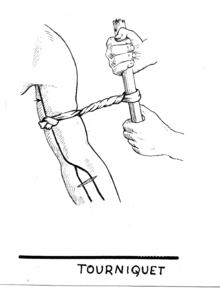
 |
|
|||||||
| Home | Forum | Online Store | Information | LJ Webcam | Gallery | Register | FAQ | Members List | Calendar | Search | Today's Posts | Mark Forums Read |
 |
|
|
Thread Tools | Display Modes |
|
|
|
|
#1 |
|
Currently @ MLO Territory
Join Date: Dec 2010
Location: Under the Shadow
Posts: 2,290
|
Shark Attack Survival- What to do?
If the inevitable happens, and your limb gets torn off. (like in Hawaii) What are you best chances of survival.?
Do we make a Tourniquet? Do we burn off our own limbs to stop it from bleeding? [IMG]  [/IMG] [/IMG]
__________________
 Team: Disbanded You only have one chance in this life...make the right decision(s)...so you don't regret it
|
|
|

|
|
|
#2 |
|
Senior Member
Join Date: Apr 2011
Posts: 110
|
With the limited resources on a yak I'd say the tourniquet is the only real option. Tie it up with a leash or some rope and hail the coast guard on ch 16.
|
|
|

|
|
|
#3 |
|
Team Keine Zugehörigkeit
Join Date: Nov 2010
Location: Way out there
Posts: 2,854
|
just limit your exposure to sharks, dont fish
__________________
 Não alimente os trolls------------Don't feed the trolls---------------インタネット荒らしを無視しろ 
|
|
|

|
|
|
#4 |
|
Senior Member
Join Date: Apr 2010
Posts: 6,856
|
A tourniquet isn't as easy as it looks, you can save the persons limb or cause them to lose it if it isn't done right.
__________________
 www.facebook.com/Teamsewer |
|
|

|
|
|
#5 |
|
Senior Member
Join Date: May 2010
Location: Cypress, CA
Posts: 789
|
__________________
 
Last edited by maui jim; 12-03-2013 at 03:48 PM. Reason: added |
|
|

|
|
|
#6 |
|
Member
Join Date: Jul 2013
Location: racoon city
Posts: 74
|
|
|
|

|
|
|
#7 |
|
Senior Member
Join Date: Apr 2013
Location: Oceanside
Posts: 1,470
|
__________________

|
|
|

|
|
|
#8 | |
|
Senior Member
Join Date: Aug 2013
Posts: 143
|
Quote:
1. only apply on arms or legs. 2. no matter where on the arm or leg the wound is, apply high, (nearest the torso) above the wound, and above the elbow or knee. 3. after making tight, ensure it can not loosen on its own. Other than that 2 things to be aware of are the fact that you place it high as possible because in the shin and foreare there are 2 bones protecting major blood vessels and placement there will not restrict blood flow properly. And the second reason you want it as high above the wound as possible is because vessels are like rubber bands, and when cut will contract back towards the heart. this means the femoral or brachial arteries could contract inside the muscle and above your planned placement of the tourniquet. Bottom line is if you think you need a tourniquet, apply one. like I said you can leave one on for up to 6 hrs. and once you place it, NEVER take it off. Leave that to surgeons who are trained and have proper equipment to deal with massive hemorrhaging. |
|
|
|

|
|
|
#9 |
|
Currently @ MLO Territory
Join Date: Dec 2010
Location: Under the Shadow
Posts: 2,290
|
Thanks for the reply. This information is good to know.
We all take the risk being on the water, and knowing what to do or what not to do in an emergency might make all the difference. http://www.wikihow.com/Apply-a-Tourniquet http://www.artofmanliness.com/2012/0...ajor-bleeding/
__________________
 Team: Disbanded You only have one chance in this life...make the right decision(s)...so you don't regret it
|
|
|

|
|
|
#10 |
|
Senior Member
Join Date: Apr 2013
Location: Oceanside
Posts: 1,470
|
Tourniquets are pretty easy to apply and if your really that worried you can buy one online that are simple and very quick to use. Theese are the same ones we used over in Afghanistan and they work very well. If you can find the ones with the metal bar those are even better.
http://www.rescue-essentials.com/hem...FSvl7AodhB0AKw
__________________

|
|
|

|
 |
| Thread Tools | |
| Display Modes | |
|
|